2007 Annual Meeting
Keynote Speaker Anders Aslund Describes Concerns for Russia’s Political and Economic Outlook
Dr. Anders Aslund, Senior Fellow at the Peterson Institute for International Economics, delivered the keynote speech at EMTA’s Annual Meeting, which was held on December 5, 2007. Citigroup hosted the event in its downtown Manhattan headquarters. Over 250 market participants attended.
 Aslund prefaced his remarks by noting the “enormous contradiction between, on the one hand, a growing and blooming market economy and, on the other hand, an ever more authoritarian political situation.” His presentation focused on five issues in Russia’s political and economic history between 1985 and 2007.
Aslund prefaced his remarks by noting the “enormous contradiction between, on the one hand, a growing and blooming market economy and, on the other hand, an ever more authoritarian political situation.” His presentation focused on five issues in Russia’s political and economic history between 1985 and 2007.
The first issue Aslund addressed was the success of market reform. In his opinion, sufficient reform work was carried out from 1991-92 to secure the market economy; Aslund ascribed the initial poor economic results to policies that did not go far enough, and added that ironically, the 1998 financial crisis completed the country’s economic transformation when it forced financial stabilization. Aslund specified that while Russia had reached the EBRD’s definition of a deregulated economy by 1994, and with 70% of GDP coming from the private sector by 1997, the country still had a budget deficit of 9% until 1998—a shortcoming only reversed when the financial crisis made expenditure cuts politically possible. However, Aslund observed, progress on major reforms has been halted since 2003.
The failure of democracy was Aslund’s second topic. Aslund attributed this to President Boris Yeltsin having no concept of democracy-building, and the accepted wisdom in Moscow that political issues were relatively unimportant compared to economic concerns. Instead of promoting democracy, Yeltsin imposed a constitution which concentrated power in the executive as a reaction to an “old, unrepresentative” and “erratic” Parliament. Yeltsin further erred when he handpicked ex-KGB official Vladimir Putin as his successor, a leader who would further stray from building a democratic Russia.
Aslund argued that the continuation of an authoritarian regime in Moscow was not pre-ordained. He contrasted the recent history of Russia with that of Ukraine, citing Freedom House standards, emphasizing that strong oil prices allowed President Putin to “indulge himself.”
The third issue Aslund addressed was an analysis of President Putin’s character. Aslund described the Russian president as an “authoritarian modernizer” in his first term. During these years, Putin concentrated his political power, engaged in a second war in Chechnya, began controlling the media and recentralized power back from regional governments; he simultaneously carried out economic reforms.
For a while, it was not completely clear what direction Putin would take next. For example, Putin’s reference to a “dictatorship of law” left analysts wondering if he would focus on judicial reform or, rather, assert presidential authority over the judiciary. However, the 2003 Yukos confiscation removed any doubt about who the ex-KGB agent really is. Since then, Putin’s major accomplishments have been little more than increasing authoritarianism and the acceptance of greater degrees of corruption, according to Aslund.
The fourth issue of Russia’s future is also “totally clear,” at least vis-à-vis the political realm, Aslund asserted, with Putin remaining firmly in control of the country, regardless of what title he retains once his current term expires. The Russian leader has successfully engineered the political situation so that he remains the sole figure necessary to prevent a government collapse. Aslund drew a parallel to the reign of Tsar Nicholas I, whose rule began with the exiling of liberals to Siberia. Putin has echoed Nicholas I’s reign by over-centralizing his personal power, ruling through secret police and increasing repression as necessary to maintain his control of the country.
Economically, the country’s outlook is more opaque. Russia should benefit from “splendid” macroeconomic policy and high economic growth; Aslund also praised the highly ambitious populace, and pointed out that a larger percentage of Russian youth go to college than their EU peers. Finally he predicted that a high level of legal private businesses bodes well for the future.
Yet the renationalization of industries remains a concern to Aslund, as does corruption. Using data from Transparency International, Aslund again compared Russia unfavorably to Ukraine. Worse, “[corruption] is not necessarily disorganized any longer…it’s very systemic,” he declared. Aslund highlighted corporate raiding by law enforcement officials, and the rising fortunes of ex-KGB agents. “How much can they steal without damaging the economy,” he questioned. Aslund also expressed concern over loose monetary policy and a decline in the fiscal surplus, both of which are causing increased inflation.
The fifth issue covered in the keynote address was President Bush’s misjudgment of President Putin. Aslund illustrated his argument with a series of quotes which ended with an acknowledgement by Bush that he had “no idea what [Putin] is going to do.”
The Peterson Institute Senior Fellow concluded his remarks on a positive note, arguing that the country’s market economy is a “stronger element” than Putin’s political authoritarianism; and that a country so rich, so pluralist and so well-educated will eventually move towards greater democracy. “When economic growth declines, or the oil price falls, then I think President Putin will fall also,” he forecast.
Sell Side Analysts Warn Investors Not to Expect Great Returns
JPMorgan’s Joyce Chang moderated the Annual Meeting’s panel of sell-side experts. Chang set the stage with a reminder that last year’s discussion had partly focused on “why Ecuador would fail”—and yet the country’s debt returned over 40% in 2007. She contrasted near conformity of forecasts on key economic variables in 2006 with the greater diversity of views at this year’s meeting, projecting a slide which demonstrated a wide range of predictions on such variables as oil pricing and the dollar/euro exchange rate. Chang also called attention to the relatively uninspiring forecasts for the EMBI global, with two firms calling for flat performance over the next twelve months and even the most optimistic prediction calling for a small tightening. Finally, Chang also noted in her introductory comments that most firms expected the Fed to continue to cut rates into 2008, with one estimate of a 200 bp cut in Fed fund rates.
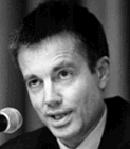 Initiating a discussion of the global economy, Credit Suisse’s Kasper Bartholdy underscored that 2008 is unlikely to be a great year for the global economy, “but that doesn’t in itself tell us that credit spreads have to widen from current levels.” He believed that despite the downturn, global growth is not collapsing and that the risk of sovereign defaults will not increase more than the level implied by current spreads. The Credit Suisse analyst cited tighter credit policies at US and European banks and decreased US consumption (following the US housing crisis) as the main reasons for weakness in global growth, while affirming that this would not lead to a “disastrous default or a long-term global slowdown” as Central Banks “will respond to the threat and loosen policies.” Bartholdy compared the current situation to the 1Q of 2007, when EM bond markets “lived pretty happily” with slow US growth.
Initiating a discussion of the global economy, Credit Suisse’s Kasper Bartholdy underscored that 2008 is unlikely to be a great year for the global economy, “but that doesn’t in itself tell us that credit spreads have to widen from current levels.” He believed that despite the downturn, global growth is not collapsing and that the risk of sovereign defaults will not increase more than the level implied by current spreads. The Credit Suisse analyst cited tighter credit policies at US and European banks and decreased US consumption (following the US housing crisis) as the main reasons for weakness in global growth, while affirming that this would not lead to a “disastrous default or a long-term global slowdown” as Central Banks “will respond to the threat and loosen policies.” Bartholdy compared the current situation to the 1Q of 2007, when EM bond markets “lived pretty happily” with slow US growth.
Paulo Leme of Goldman Sachs admitted to being a proponent of the “re-coupling camp,” cautioning that it would be hard for the rest of the world not to “take the hits” from lower US growth, while acknowledging the great amount of uncertainty concerning the world economy. Goldman had recently revised the chances of a recession to 40-45%, Leme pointed out, and credit tightening could “prove to be more contractionary, and to endure longer, than we are forecasting.” However his overall impression was that EM markets will deal relatively well with contractionary shocks coming from G-7 countries, largely due to strong fundamentals, with BRICs perhaps being hit in the range of 20-50 bps.
 Merrill Lynch’s Tulio Vera noted that some of the recent themes in the global economy – weak US dollar, strong Chinese growth and strong commodity prices – should continue in 2008. As for other macro factors, Vera recognized that his firm is the most bearish on US growth, with a 1.4% growth forecast next year, and not expecting a recovery (U-shaped in Merrill’s forecast) until the end of 2008 or beginning of 2009. As long as the US avoids a recession, EMs could probably eek out their third consecutive year of roughly 8% economic growth, he believed. However commodity pricing could falter if the US goes into a recession and growth falters in Japan and Europe as well.
Merrill Lynch’s Tulio Vera noted that some of the recent themes in the global economy – weak US dollar, strong Chinese growth and strong commodity prices – should continue in 2008. As for other macro factors, Vera recognized that his firm is the most bearish on US growth, with a 1.4% growth forecast next year, and not expecting a recovery (U-shaped in Merrill’s forecast) until the end of 2008 or beginning of 2009. As long as the US avoids a recession, EMs could probably eek out their third consecutive year of roughly 8% economic growth, he believed. However commodity pricing could falter if the US goes into a recession and growth falters in Japan and Europe as well.
Chang offered JPMorgan’s assessment of a 35% probability of a US recession, with an EM growth forecast above 6%. She noted that JPMorgan had only made downwards adjustments in GDP projections for Mexico and Kazakhstan.
Addressing the likely direction of the US dollar, Leme saw the greenback as at least 20-22% undervalued, and expected strengthening over the next 12-18 months, in marked contrast to recent EM currency appreciations. Leme expected market volatility, and suggested timing a depreciation bet would prove challenging. For the near-term, however, US FOMC rate cuts and other factors should keep the dollar relatively weak, he argued. Bartholdy largely concurred, and added that EM countries such as China, Russia and other oil-producers will allow their currencies to appreciate in order to mitigate inflationary pressures.
Disagreeing, Vera viewed the dollar as being closer to fair value. Vera expected EM currencies to peak in value vis-à-vis the dollar in the 1H of 2008, promoted in Asia by monetary tightening. Chang concluded the dollar direction discussion by noting JPMorgan is forecasting a 10% return on EM currencies in dollar terms in 2008, led by countries such as Turkey (with a 22% return forecast, although “not the one-way bet it was a year ago,” she warned).
Chang polled speakers for their opinions on an EM “de-coupling.” Vera noted that 2007 US growth slowed to around 2% while global growth increased to approximately 6%, thus, in terms of growth “the de-coupling thesis has worked out pretty well.” The relatively higher return of EM assets vs. G-7 instruments has also supported the de-coupling story in the marketplace, he observed. The risks to de-coupling, e.g. a dollar crisis and a subsequent shunning of dollar-denominated assets as well as inflation, do not appear imminent; while the growth of sovereign wealth funds means that there is now a “put” on risky assets that can be used as stabilizers in an economic downturn. “The bottom line is decoupling will hold for this year,” he concluded.
Bartholdy agreed, but advised that he based his opinion on Credit Suisse’s more optimistic prediction of the G-3 economic slowdown. He questioned whether de-coupling would continue if Merrill’s more pessimistic forecast of US growth proved true.
Chang asked Anne Milne of Deutsche Bank, the panel’s corporate expert, if de-coupling would continue in the corporate arena. Milne ventured that there is less de-coupling in high-grade liquid names such as Lukoil, CEMEX, America Movil and CVRD as there is “more transparency on where their international comparables would be.” Second-tier names might be more affected by other factors including corporate finance developments and government policies affecting their industries.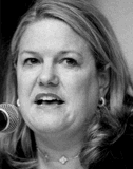
On the growth side, Leme said the healthier sovereigns would de-couple from developed markets but suggested others wouldn’t fare as well. On the trading side, “it is impossible to escape from very high correlations or episodes of bad news.” Leme espoused a strategy of opportunistic trading, buying some of the credits mentioned by Milne on dips of 10-15% and selling into rallies. Chang ended the decoupling discussion by highlighting JPMorgan’s bullish Chinese forecast, “which is central to our view that EM will not face a massive downturn even if the US goes into recession.”
The panel addressed EM debt valuations. Bartholdy explained his use of rating agency data and current sovereign spreads to determine if investors are receiving appropriate compensation for holding EM debt. While acknowledging that one could always debate the appropriate methodology, his analysis showed that creditors were in fact receiving “generous compensation” for owning investment-grade rated EM sovereigns, while sub-investment grade debt offered investors “just about” the right return. Vera voiced his opinion that EM looks rich compared to US credit and that probably isn’t going to change in the near future due to “the credit stresses” in the US and supply overhang.
How does one value EM corporates? Milne responded that, while the spread levels on high-grade paper from developed economies is the most important determinant, in some cases EM credits are actually more financially sound, with some EM companies such as Petrobras and the Chilean paper companies trading through US peers. Milne currently favors the Kazakh bank sector, Mexican industrials and Argentine corporates in general and utilities specifically from a valuation point of view, but clearly conveyed that investors should not expect large returns. Milne warned that valuations would be very complicated and one “almost has to have a matrix for every single industry group to figure out how they’re performing.”
Milne was asked to further discuss EM corporate performance in 2008 as well as issuance trends. Milne noted that approximately $190 billion in corporate paper had been issued in 2007, 28% above 2006 levels. However, Milne expects a slowdown in 2008, mostly a result of a 30% decline in EMEA corporate issuance following an inability by the region’s banks to obtain additional funding. Milne also stressed the role of local currency-denominated corporate paper, which has surpassed hard currency-denominated issues in recent years. This bodes well for EM corporates, which can turn to local markets for refinancing when international markets are closed.
As for other corporate products, Milne expects syndicated loans to remain stable or possibly decrease, and the corporate CDS market continues to evolve though not as rapidly as had originally been expected (“once you go beyond the larger less-liquid names, it’s sort of tailor-made, by appointment.”) Milne expects growing interest in asset-backed securities, which tend to be for lower- or non-rated companies and be small in size.
As for top picks for 2008, Vera chose Colombia, Turkey, Venezuela and Indonesian external debt, Brazilian utilities and meatpackers, Mexican telecom, as well as Russian banks and steel companies. He also spoke positively about the ruble, Korean won, Chinese yuan, Malaysian ringgit and Argentine peso.
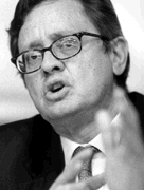 Leme recommended long positions in rubles, Asian currencies and the real. He viewed CDS on Argentina as cheap, in addition to CDS on Columbia, Peru and Brazil. He spoke enthusiastically on the outlook for Brazilian energy and exporter firms, while agreeing with Milne that second tier names could offer even more attractive returns.
Leme recommended long positions in rubles, Asian currencies and the real. He viewed CDS on Argentina as cheap, in addition to CDS on Columbia, Peru and Brazil. He spoke enthusiastically on the outlook for Brazilian energy and exporter firms, while agreeing with Milne that second tier names could offer even more attractive returns.
Milne recommended Argentine utilities and KKB and BTAS of Kazakhstan. She urged money managers to avoid smaller Mexican home builders which don’t have access to the local debt or equity market.
Bartholdy viewed Russian sovereign debt as cheap, and agreed with Leme on Argentina’s pricing (though cautioning that he would like to see signs of policy changes before committing to large investments). He would underweight EM equities.
Chang asked rhetorically whether Ecuador could again surprise the market as it had in 2007. She also recommended Argentine GDP warrants, the Nigerian naira, and Turkish rates, while avoiding the rand and Romania. Finally she detailed her concern about a potential balance of payments problem in Kazakhstan.
Investor Panelists Debate Decoupling, Quest for Returns in 2008
Citigroup’s Don Hanna, who moderated the event’s second discus sion, asked each of the Annual Meeting’s investor panelists to summarize their current thoughts on the market and to identify their concerns. NWI Investment Management’s Hari Hariharan viewed his job as making four calls in 2008: the US economy, decoupling vs. recoupling, inflation and the underlying “infrastructure plumbing” or soundness. After reviewing his thought on each, Hariharan concluded that “many of these factors are eminently fixable” and that “the opportunities to make money are going to be fantastic next year.”
Art Steinmetz (Oppenheimer) commented “it’s probably time we had a recession in the United States.” He affirmed he was “out of the closet” on being “a de-coupler” despite attacks on the decoupling  theory in recent months. “I would not claim in any sort of “Pollyannish” fashion that there is no risk to these economies from a recession in the developed world, merely that the sandbags around these countries are much higher than they used to be,” he asserted. Steinmetz noted increased domestic demand in EMs, especially in the BRICs, the ability for EMs to run countercyclical monetary policy, and the fact that the current slowdown has been triggered by a financial crisis (rather than a tradable goods crisis) all make strong arguments for decoupling.
theory in recent months. “I would not claim in any sort of “Pollyannish” fashion that there is no risk to these economies from a recession in the developed world, merely that the sandbags around these countries are much higher than they used to be,” he asserted. Steinmetz noted increased domestic demand in EMs, especially in the BRICs, the ability for EMs to run countercyclical monetary policy, and the fact that the current slowdown has been triggered by a financial crisis (rather than a tradable goods crisis) all make strong arguments for decoupling.
“The US is pretty lucky to have Bernanke,” according to BlueBay Asset Management’s Simon Treacher, who praised the US Fed policy chief. As for decoupling, Treacher voiced his opinion that if US growth stayed at below 2% for a while, it would be impossible for the EMs not to get dragged down as well. He expected a U-shaped recovery and “a long year” in 2008.
Jim Barrineau of AllianceBernstein described the “secular shift” that occurred between 2002-06 when the US current account deficit expanded; EM countries, flush with liquidity, began posting trade surpluses and large GDP increases. This period has ended, Barrineau surmised, and as result EM assets will not be the “no brainer” they were for the past couple of years. Barrineau concurred with Treacher on the recovery being U-shaped, and also noted that sovereign wealth funds would have less room to accumulate dollar reserves in the current environment. He stressed that the pace at which Central Banks would add liquidity to the system would prove crucial to the global economy and that buildups in FX reserves and trades surpluses could be unwound if adequate re-liquefaction does not occur.
The panel also debated the possible risks from China to the EMs. Barrineau considered China to be more important to the emerging world than the US in recent years, but wondered if the country’s new sovereign wealth fund might spend more money on local bank problems than other global assets. A Chinese stock market correction or an over-tightening of monetary policy could immediately be reflected in commodity prices and thus transmitted to EM asset pricing.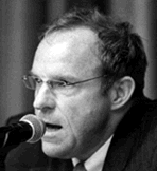
EMTA’s 2007 Annual Meeting concluded with investor panelist recommendations. Steinmetz discussed the potential for renewed strength in the dollar, and offered Brazilian local rates as a preferred trade. Treacher reaffirmed his interest in Ecuador, but admitted he had not been so concerned about the market’s prognosis for almost a decade. He suggested he would be somewhat on the sidelines until the direction of the global economy became clearer, but “if the information starts going against me then I’ll just be short everything.”
Barrineau agreed with sell-side analysts who favor the ruble and Asian currencies, and with Steinmetz’s call on Brazilian rate trades. Global uncertainty and the decreased tailwind 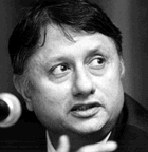 have probably lessened his uncertainty for EM assets generally, he acknowledged.
have probably lessened his uncertainty for EM assets generally, he acknowledged.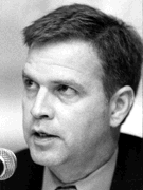
Hariharan would short the euro and sterling (the latter being “probably the greatest single bubble in the world right now”) against Asian currencies. He agreed with Treacher that there would be unusual “opportunities to prey on distressed debt.”